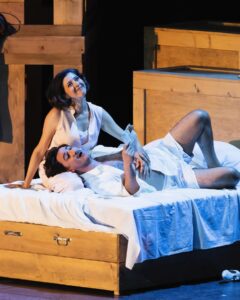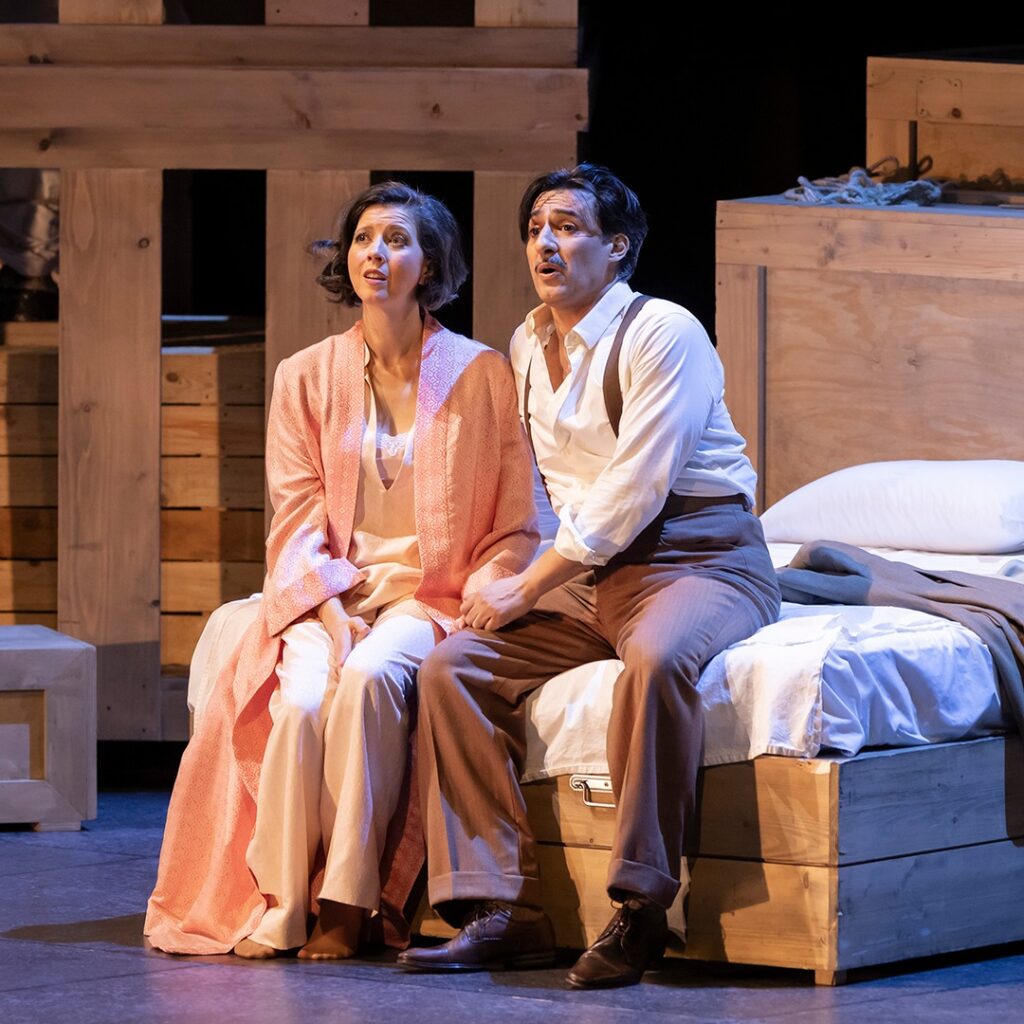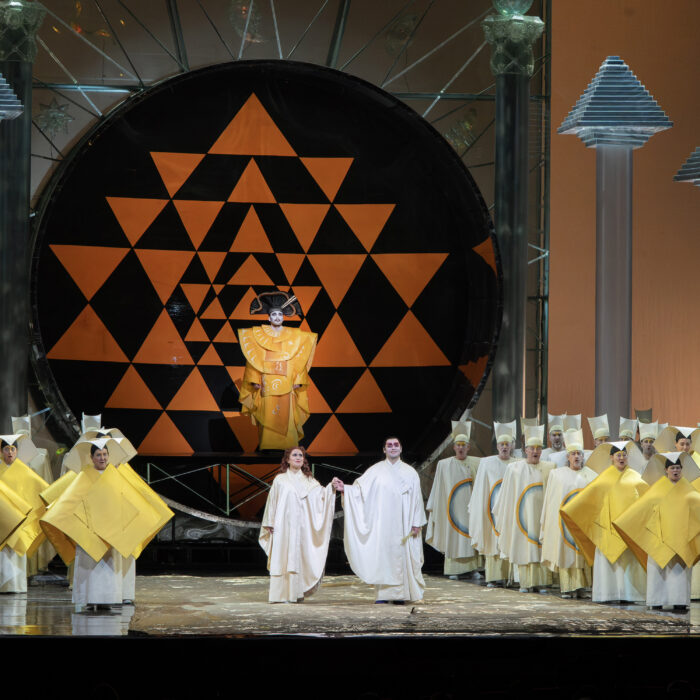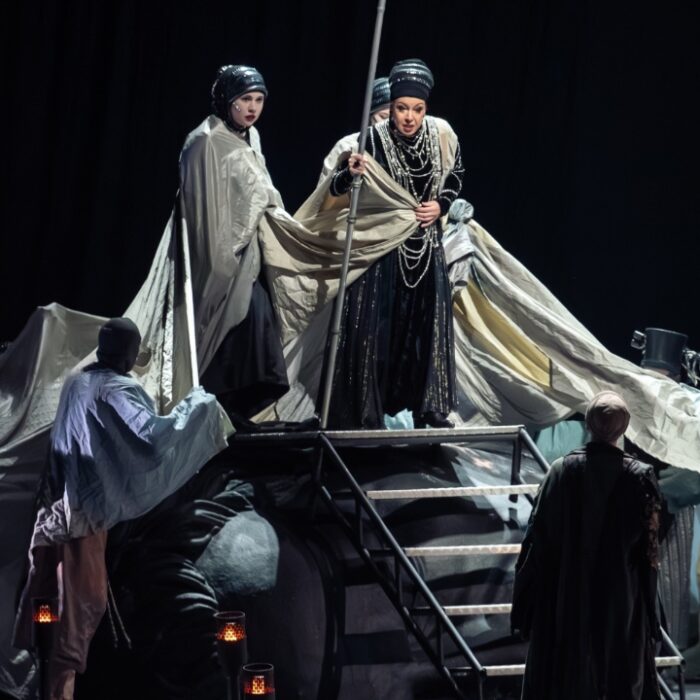
Palau de Les Arts 2024-25 Review: Manon
Lisette Oropesa & Charles Castronovo Deliver Passionate Performances in Massnet’s Masterpiece
By Mauricio Villa(Photo: Arts Fotografía)
Palau de Les Arts opened the season with Massenet’s “Manon,” in a production from the Paris Opera, and two international stars in the main roles: Lisette Oropesa and Charles Castronovo.
Vincent Huguet directed the Paris Opera production. He set the action in Paris around 1920, in the Charleston era, and introduced the revolutionary artist Josephine Baker (who debuted in Paris in 1925) into the narrative. Baker leads Manon throughout the story as a sex symbol, bringing her into the luxury, dancing, and casino scene. It is Baker whose Manon leaves her with, abandoning her modest life with Des Grieux at the end of the second act.
Huguet even introduces a musical number with a song by Baker before Act two, and shows how Baker teaches Manon to dance, which would be a metaphor for the feminism and the revolution that the artist left in Paris. It is very difficult to add music from another period into an opera production with good results, but Huguet’s inventiveness does not distract from the original plot. His original concept adds realism to the action and makes the characters more human and believable. He directs with a naturalistic and realistic acting approach, and every single artist on the scene is clearly defined.
He treats the chorus as if they were individual characters rather than a uniform group of people and their appearances are full of actions. Every single line of the principal singers is directed, giving sense to everything, running away from opera clichés, and giving acting tools to the performers. He used dancers (even the soloist and chorus dance) and presented the ballet in Act three, which is usually cut. Jean-François Kessler created a brilliant modern choreography that suited Massenet’s music and the libretto perfectly. The big realistic sets, designed by Aurélie Maestre, are imprinted with art déco style matching the 1920 period.
Two Passionate Lovers
Lisette Oropesa portrayed the title role. She possesses a round velvety timbre whose middle range has expanded and gained in depth and projection. Her entrance aria,”Je suis encore tout étourdie” showed her strong round sound and her fine bel canto technique. This was best displayed with her voice’s soaring pianissimo rising to a high B flat and in the cadenza which demands a fast scale up to a high E (Oropesa opted for the leggera variations that Massenet wrote in the score, as this cadenza is optional).
Then in her first act duet, she was ardent, moving, and dramatic delivering strong ringing B flats, and in her second act aria, “Allons! Il le faut…adieu notre petite table” she was moving. The first scene of the third act, the Le Cours la Reine scene, was the moment where the soprano showed all her virtuosic technique by immaculately singing all the staccato notes and displayed incredible ascensions to B naturals and two strong and secure D naturals. She was warmly rewarded by the audience as she received the strongest applause of the night after this aria.
But she still had more high notes to deliver in the night as was displayed in her ringing high Cs and Ds in the Casino scene. She was ardent in her duet with tenor Charles Castronovo in the Saint Sulpice scene and sang a very emotional and moving final scene as she was dying. Her characterization was more sensual and stronger than the usual naïve poor girl that it is usually presented, making her inclination towards luxury more believable.
Tenor Charles Castronovo sang the role of the lover Des Grieux. He has a lyrical voice with a dark timbre and modest projection. His French phrasing and legato were impeccable and his high notes were effortless and secure. He took some time to warm up and that was most noticeable in the first act as his voice got lost during the duet with Oropesa’s, especially when they sang high notes together. But something changed throughout the night as Castronovo gained vocal weight and projection. He sang the “dream aria” “En fermant les yeus” with a soaring mezza voce, sounding sweet and delicate, delivering a pianissimo high A natural in “Il y faut encore.”
But the highlight of his performance was his third act aria, ”Ah! Fuyez douce image,” where he made clever use of the dynamics and contrasted the pianissimo sweet moments with strong high B flats. He was ardent and explosive at the end of his subsequent duet with Manon, strong and determined during the casino scene, and shared the soprano’s pathos and sadness during the moving final duet which closes the opera.

Arts Fotografía
More Cast Highlights
The rest of the characters, although very important for the plot, only sing in ensemble or a few spare lines, making the soprano and the tenor the true protagonist of the opera. Nevertheless, the cast was superb, with the cynical and vocally strong Carles Pachon as Lescaut, a youthful Le Comte des Grieux by bass James Creswell ( This role is usually played as an old man, but Huguet takes advantage of the tenor’s youth to make the role believable) and a rich timbered Jorge Rodríguez-Norton as Guillot de Morfontaine. The splendid Poussette, Javotte, and Rosette were portrayed by Antonella Zanetti, Laura Fleur, and Ester Ferraro (all members of the young artist program of the theatre).
Musical director James Gaffigan was in charge of the Orquesta de la Comunitat Valenciana. If I had to remark upon his direction of Massenet’s opera in just a few words, it would be about his enthusiastic and vigorous approach. From the opening short prelude with the explosive outburst from the orchestra to the lively and brilliant “Cours la Reine” in Act three. Gaffigan made the orchestra sound enthusiastic and cheerful, particularly with his fast but precise tempi. He followed the phrasing of the singers and contrasted it with sweet lyricism, particularly in Manon’s second act, Des Grieux’s “Ah fuyez” and mostly in the final duet, which was moving and intense. The orchestra and chorus sounded strong and brilliant.
Overall, this was a clever and beautiful production staged by Huguet, with a lively and enthusiastic musical approach by James Gaffigan, and outstanding interpretations by Oropesa and Castronovo.


